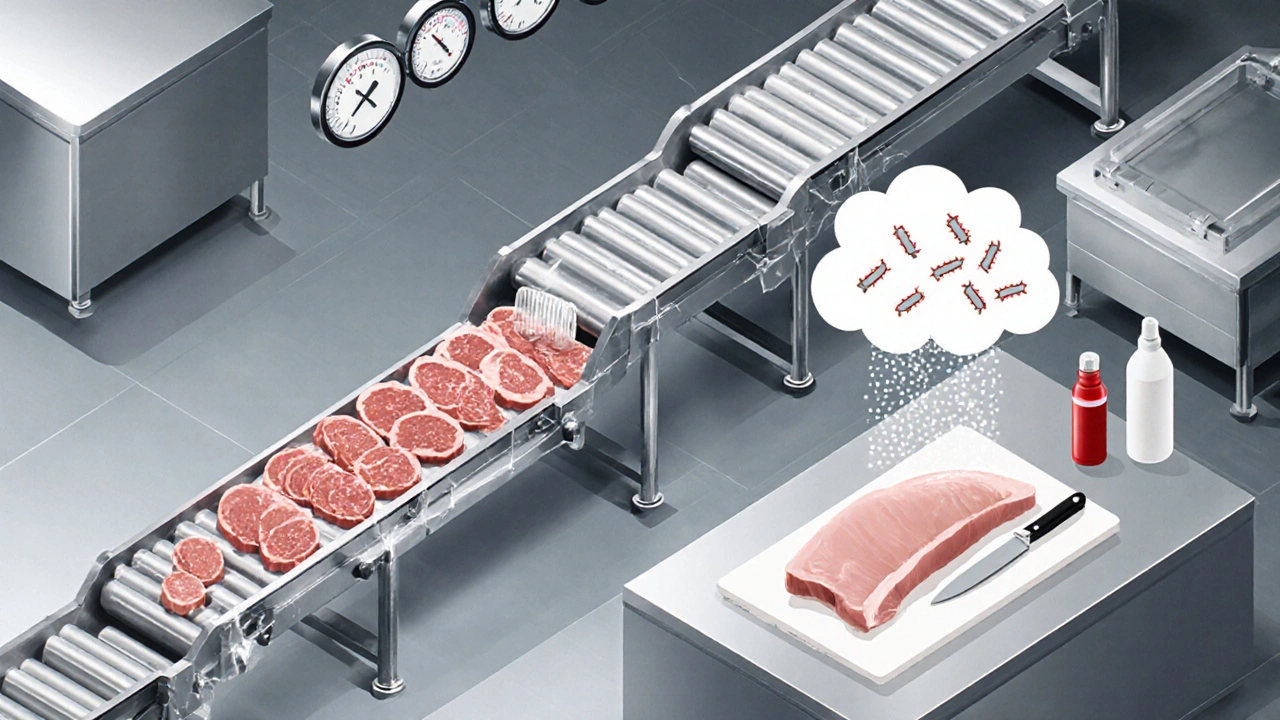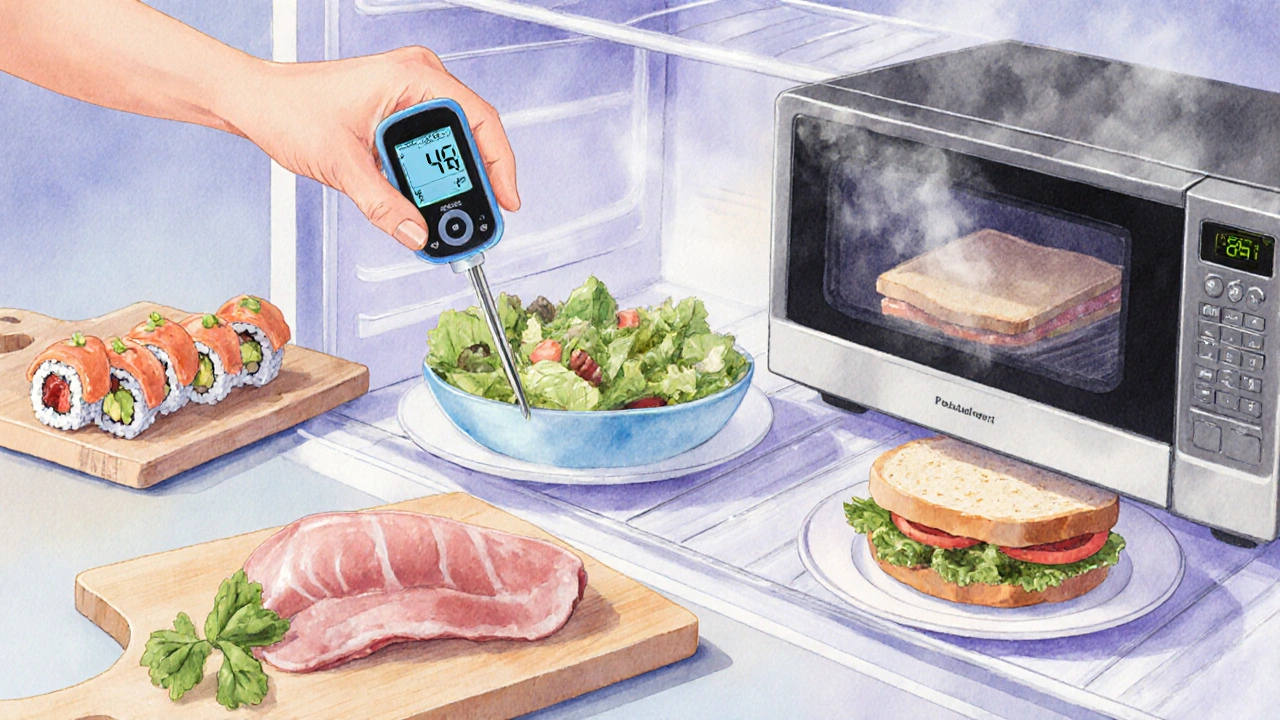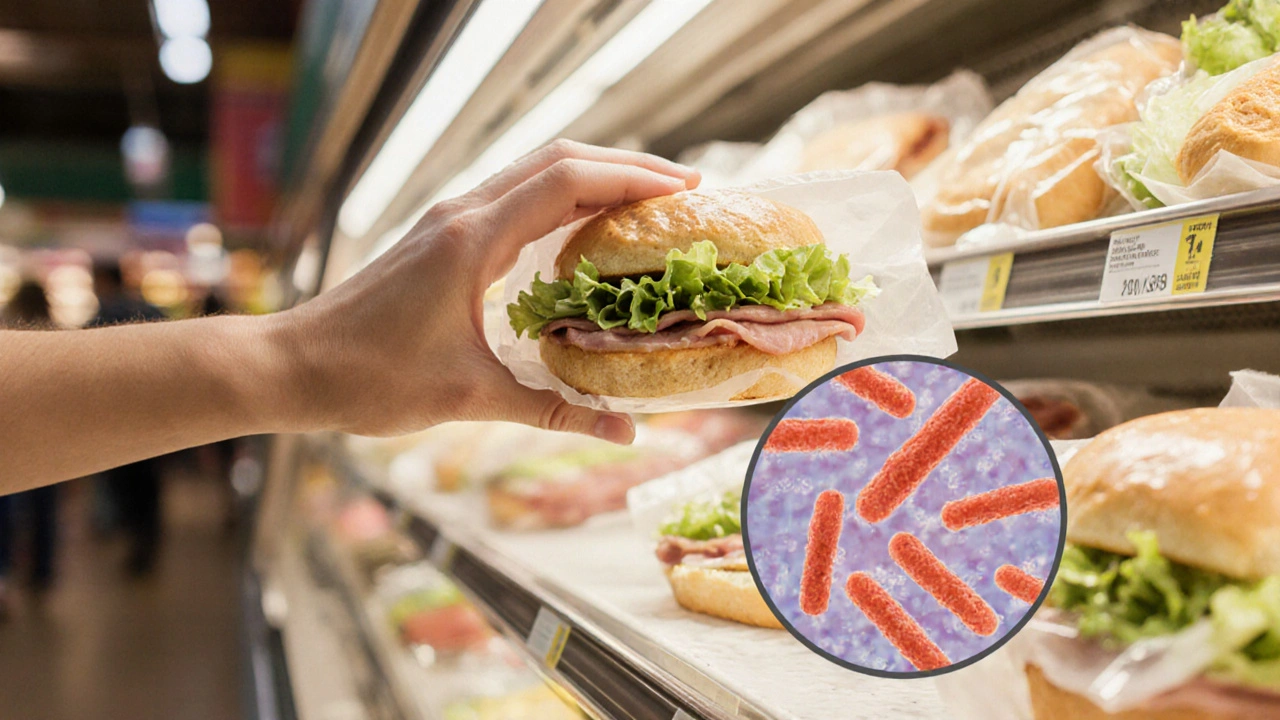Salmonella Risk Assessment Tool
Assess Your Food Safety Risk
Enter your food details to determine Salmonella risk level and receive safety recommendations.
Ever grabbed a pre‑packed sandwich or a chilled sushi roll and wondered if it could make you sick? The truth is, ready‑to‑eat (RTE) foods can sometimes hide a silent threat: Salmonella is a gram‑negative bacterium that frequently causes foodborne illness worldwide.
What Is Salmonella?
Salmonella is a rod‑shaped bacterium belonging to the Enterobacteriaceae family. It thrives in warm, moist environments and can survive on foods for weeks if stored improperly. In humans, it targets the intestinal tract, leading to inflammation and a range of symptoms.
Why Ready‑to‑Eat Foods Are Vulnerable
RTE foods are designed for consumption without any additional cooking step. That convenience means they bypass one of the most reliable kill‑steps for bacteria-heat. When a product is produced, packaged, and shipped already safe to eat, any lapse in hygiene, temperature control, or equipment cleaning can let Salmonella slip through.
- Minimal processing after packaging.
- Extended shelf‑life encourages storage at “borderline” temperatures.
- High moisture content in salads, deli meats, and fresh fruits provides a perfect breeding ground.
How Salmonella Contaminates RTE Foods
Contamination can happen at several points:
- Raw ingredient sourcing. Poultry, eggs, and sometimes fresh produce carry the bacteria.
- Cross‑contamination. Cutting boards, knives, or conveyor belts that touch raw meat and then RTE items.
- Inadequate cooling. Holding foods above 4°C (39°F) for too long lets the bacteria multiply.
- Packaging breaches. Improper seals can allow airborne contamination.

Symptoms, Incubation, and Who’s Most at Risk
The Incubation period for salmonella infection typically ranges from 6 to 72 hours after ingestion. Early signs include:
- Sudden abdominal cramps
- Diarrhea (sometimes bloody)
- Fever up to 39°C (102°F)
- Vomiting
Symptoms usually last 4-7 days, but dehydration can become serious, especially for the elderly, infants, and immunocompromised individuals.
Recent Outbreaks: Lessons Learned
From 2023 to 2025, several high‑profile outbreaks highlighted the ongoing danger:
- 2023: A pre‑cut salad mix sold across New Zealand linked to 84 cases, traced back to a contaminated irrigation system.
- 2024: Ready‑to‑heat chicken nuggets in a major supermarket chain caused 112 hospitalizations in Australia due to inadequate post‑cook cooling.
- 2025: A global recall of packaged sushi rolls after an investigation revealed Salmonella in the salmon used for the filling.
Each incident underscored the need for stricter food safety protocols and better consumer awareness.
Prevention Tips for Consumers
Even though you can’t control factory‑floor practices, you can cut your own risk dramatically:
- Check the date. Always look for a clear "use by" or "best before" label. Discard anything past its date.
- Keep it cold. Store RTE items at or below 4°C. Use a fridge thermometer to be sure.
- Separate raw and ready. In your kitchen, keep raw meat on the bottom shelf and separate cutting boards for raw versus ready foods.
- Reheat when in doubt. Even though the product is labeled "ready to eat," heating to an internal temperature of 74°C (165°F) kills most bacteria.
- Inspect packaging. Avoid products with swollen, torn, or leaking packs-these are red flags for contamination.

Industry Controls: HACCP and Regulation
The backbone of commercial safety is HACCP (Hazard Analysis and Critical Control Points). This systematic approach pinpoints where contamination could occur and enforces strict limits:
- Critical limits for cooking temperature (≥74°C for at least 15seconds).
- Regular microbiological testing of finished products.
- Documentation of cleaning schedules for all equipment.
In New Zealand, the New Zealand Food Safety authority mandates that any RTE food business must have a validated HACCP plan and must report any suspected outbreak within 24hours.
What to Do If You Suspect an Infection
Early action can prevent complications:
- Drink plenty of oral rehydration solutions (ORS) to replace fluids and electrolytes.
- Contact your GP if you experience high fever, blood in stool, or symptoms lasting more than 3 days.
- Inform local health officials-your case helps track potential outbreaks.
- Preserve any suspected food packaging; authorities may request it for testing.
Most healthy adults recover without antibiotics, but severe cases, especially in vulnerable groups, may require targeted therapy prescribed by a medical professional.
Quick Reference Checklist
- Check expiration dates before purchase.
- Store RTE foods at ≤4°C immediately.
- Use separate utensils for raw and ready foods.
- Reheat when unsure-aim for 74°C internal temperature.
- Report adverse reactions to health authorities.
| Food Type | Typical Salmonella Risk | Recommended Storage | Reheat Guideline |
|---|---|---|---|
| Deli meats (ham, turkey) | High | ≤4°C, use within 3 days | 74°C for 15seconds |
| Pre‑cut salads | Medium | ≤4°C, use within 5 days | Optional - 74°C if questionable |
| Ready‑to‑eat sushi | Medium‑High | ≤4°C, consume within 24hours | Not typical; consider heating for safety |
| Packaged cooked rice | Low-Medium | ≤4°C, consume within 4 days | 74°C for 30seconds |
| Pre‑made sandwiches | Low | ≤4°C, consume within 2 days | Optional - 74°C if ingredients include poultry or egg |
Frequently Asked Questions
Can I get salmonella from cold cuts?
Yes. Cold cuts are often sliced after cooking, and if the slicer or storage fridge isn’t cleaned properly, Salmonella can re‑contaminate the meat.
Is it safe to eat sushi that’s been in the fridge for two days?
Sushi contains raw fish, which can harbor Salmonella or other pathogens. The safest practice is to eat it within 24hours of purchase and keep it at ≤4°C.
Do I need antibiotics for salmonella?
Most healthy adults recover with fluid replacement alone. Antibiotics are reserved for severe cases, infants, the elderly, or those with weakened immune systems.
What temperature kills salmonella?
Salmonella is destroyed at 74°C (165°F) held for at least 15seconds.
How long can I keep pre‑packed sandwiches?
Store them at ≤4°C and consume within 2 days. If the sandwich contains poultry, egg, or mayo, treat it as high‑risk and consider reheating.


Kenny ANTOINE-EDOUARD
October 13, 2025 AT 18:25Keeping ready‑to‑eat foods at or below 4 °C is the single most effective step you can take to limit Salmonella growth.
Always check the “use by” or “best before” date before you buy or eat a pre‑packed item.
If you’re unsure about the storage history, reheating to an internal temperature of 74 °C (165 °F) for at least 15 seconds will kill the bacteria.
Separate raw meat and ready‑to‑eat foods in your fridge to prevent cross‑contamination.
And finally, discard anything that looks, smells, or feels off – it’s not worth the risk.
Craig Jordan
October 17, 2025 AT 05:45While many consumers automatically reach for the reheating recommendation, the reality is that the blanket advice to heat everything to 74 °C can be both unnecessary and counterproductive.
First, certain foods like sushi are prized for their texture and flavor, and reheating them fundamentally changes the eating experience.
Second, the majority of Salmonella outbreaks linked to ready‑to‑eat items stem from improper storage rather than an initial lack of heat treatment.
In fact, keeping a reliable fridge thermometer and ensuring the temperature never exceeds 4 °C is a more reliable safeguard than a post‑purchase oven blast.
Third, the pathogen’s growth curve is exponential, meaning that even a small breach in cold chain integrity can cause rapid multiplication.
Consequently, if a product has been stored correctly, the risk of significant bacterial load at the point of purchase is minimal.
Moreover, the thermal death time for Salmonella at 74 °C is well‑established, but prolonged exposure beyond a few seconds can degrade nutrients and organoleptic qualities.
Fourth, consumer behavior studies show that the inconvenience of reheating leads many to skip the step altogether, thereby defeating the purpose of the advice.
Fifth, the food industry already applies HACCP controls that include mandatory cooling phases and microbiological testing before products leave the facility.
Sixth, public health data from 2023‑2025 indicates that the majority of recalls involve packaging breaches, not insufficient cooking.
Seventh, the risk assessment tools embedded in many product websites often overestimate danger by assuming worst‑case storage times.
Eighth, the variability in home refrigerators-door openings, ambient kitchen temperature, and load size-creates more uncertainty than a single reheating step.
Ninth, the psychological impact of telling people “just heat it” may cause complacency about other crucial practices like hand hygiene.
Tenth, when we focus exclusively on heat, we overlook the benefits of alternative interventions such as acidified dressings that can suppress bacterial growth.
Eleventh, the economic cost of reheating-extra energy usage-adds up for households trying to be environmentally conscious.
Twelfth, the cultural significance of certain RTE foods, especially in Asian cuisines, is diminished when they’re forced into a one‑size‑fits‑all safety protocol.
Finally, a more nuanced approach that emphasizes proper storage, date checking, and selective reheating when there’s doubt provides a balanced path to safety without sacrificing culinary enjoyment.
Jeff Quihuis-Bell
October 20, 2025 AT 17:05Grab your fridge thermometer right now and start logging the temperature every few days – it’s a game‑changer!
When you see the reading creep above 4 °C, move that food to a colder spot or toss it.
Even a brief exposure to warm air while the door is open can let Salmonella multiply fast.
Reheat anything that contains poultry, eggs, or mayo to 74 °C for at least 15 seconds; the heat does the killing.
And remember, a quick sniff and visual check can spot spoilage before it makes you sick.
Jessica Tang
October 21, 2025 AT 20:51If you ever notice a sour smell or a slimy texture, it’s a clear sign that the product has started to break down.
Don’t gamble on “just a little bit off” – the bacteria are already working behind the scenes.
Throw it away, clean the container, and reset your fridge temperature if needed.
Tracy Winn
October 23, 2025 AT 00:38No need to overthink a simple expiration label.
Jessica Wheeler
October 24, 2025 AT 04:25It is our civic duty to hold manufacturers accountable for lax safety standards; we cannot simply accept contaminated RTE foods as a normal risk.
When a company releases a product that can make people ill, they should face fines, recall mandates, and public transparency about testing failures.
Mikayla Blum
October 25, 2025 AT 08:11i've often wonderd why we trust pre‑packed meals so much when the odds of mishandlin are real.
the mind plays tricks, telling us "it's ready" while the bacteria have a silent party inside.
knowledge + simple habits = safety, but most of us just roll the dice.
Jo D
October 26, 2025 AT 11:58The whole “reheat to kill bacteria” paradigm is nothing more than a legacy mitigation strategy that ignores modern supply‑chain analytics, predictive microbiology, and real‑time temperature monitoring.
Instead of relying on a post‑hoc thermal shock, we should be leveraging IoT‑enabled cold‑chain sensors that flag deviations before the product even reaches the consumer.
In practice, this means integrating statistical process control (SPC) algorithms with machine‑learning models trained on pathogen growth curves – a far more sophisticated approach than simply telling the end‑user to heat it for fifteen seconds.
Until such infrastructure is ubiquitous, the blanket reheating advisories remain a blunt‑instrument safety net that trades culinary integrity for marginal risk reduction.
Sinead McArdle
October 27, 2025 AT 15:45While the jargon can be dense, the key takeaway remains simple: keep things cold, check dates, and reheat when in doubt.
Katherine Krucker Merkle
October 28, 2025 AT 19:31I always keep a fridge thermometer on the door and set a reminder on my phone to check it weekly; that habit has saved me from a few close calls.
Mark Quintana
October 29, 2025 AT 23:18what about the temperature swing when you open the fridge door frequently? i notice that even a few minutes of warm air can bring the internal temp up a couple of degrees, which might give bacteria a tiny boost if the food is already near the limit.
Brandon Cassidy
October 31, 2025 AT 03:05That’s why establishing a habit of quick door openings and minimizing the time the fridge is ajar is a low‑effort way to keep the temperature stable, especially for high‑risk items like deli meats or pre‑cut salads.
Taylor Yokum
November 1, 2025 AT 06:51Think of your fridge as a tiny sanctuary for perishable foods; when you respect its temperature limits, you’re essentially giving the bacteria a locked door they can’t pick.
Halle Redick
November 2, 2025 AT 10:38Your next sandwich can be both safe and delicious – just keep it chilled and give it a quick heat blast if you’re ever unsure.
Max Canning
November 3, 2025 AT 14:25Don’t let fear stop you from enjoying ready‑to‑eat meals; just follow the three‑step rule: check the date, keep it cold, reheat when you have any doubt.
Nick Rogers
November 4, 2025 AT 18:11Indeed; the guidance is clear-maintain ≤4 °C storage and apply heat treatment only when necessary.
Tesia Hardy
November 5, 2025 AT 21:58Remember, small steps add up: a quick sniff, a glance at the label, and a thermometer check can keep you safe without turning every meal into a lab experiment.
Matt Quirie
November 7, 2025 AT 01:45It should be noted that regular cleaning of refrigerator shelves and door seals also plays a crucial role in preventing cross‑contamination from stray droplets or spills.
Pat Davis
November 8, 2025 AT 05:31Regulatory agencies have tightened standards for ready‑to‑eat products after recent outbreaks, mandating more frequent microbiological testing and stricter temperature controls during distribution.
Mary Wrobel
November 9, 2025 AT 09:18So next time you grab that sushi roll, you’ll be the hero of your own kitchen, armed with knowledge and a reliable thermometer.